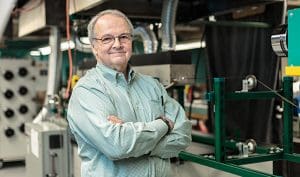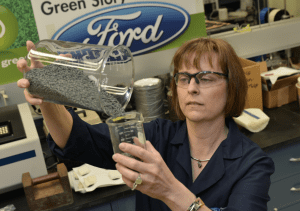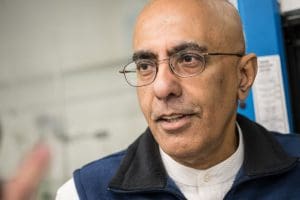This article has been reposted from MSUToday.
Building greener vehicles with help from plants
Spartan engineers and Ford Motor Co. are creating new polymers and composites for the automotive industry using sustainable materials from nature

As a building material, bamboo is pretty amazing. Even though it’s technically a grass, bamboo’s reeds can be tougher than timber. It also grows fast, helping make it more sustainable than lumber.
None of this is a secret to environmentally conscious consumers who have welcomed bamboo into their homes as desks, flooring and cutting boards, to name just a few applications. Still, as ubiquitous as bamboo is, people might be surprised to find it in their cars, which could be a reality in the not-too-distant future.
That’s the future that researchers at Michigan State University and collaborators in the automotive industry — especially at Ford Motor Co. — are working to create. Not just with bamboo, but an array of other plant materials to help cut costs and carbon emissions while making cars and trucks.
And where else would you see this charge but in Michigan? With its legendary automotive history and forward-looking auto shows, the state provides fertile grounds for this story. It’s a story rooted in the past, in innovators who have always valued teamwork and resourcefulness. But it’s also about the future, about ongoing partnerships and the next generation of Spartans, for whom “Go Green!” is more than a cheer. It’s a way of life.
The grass is always greener

Lawrence Drzal, a University Distinguished Professor in the College of Engineering’s Chemical Engineering and Materials Science Department, has been working to reduce the cost of composites used in cars for decades. Of course, he didn’t want to trade off on their performance either, meaning he needed materials that were both strong, tough and abundant.
“What was kind of ignored and was an area that had potential was plant fibers,” Drzal says. Wood was an obvious first choice for its strength, but trees take years to grow and harvest. And, after all, time is money, so he shifted his attention to grasses, including bamboo.
“Grasses can grow to maturity in about three to four months, they’re perennial, and their stems have very good properties,” Drzal says. “Plus they’re biodegradable and can be recycled. There are a whole lot of benefits.”
As it turned out, though, Drzal, like many innovators, was ahead of his time.
“We did a lot of work in our group with these fibers in the early 2000s, but the one thing that was lacking was a technological pull,” he says. “We would investigate these materials, show they had good properties, but typically didn’t offer any savings. They were a nice curiosity, but they weren’t used very much.”
To understand what Drzal means about savings and technological pull, it’s important to understand the existing composites his new materials were competing against.
Drzal and his team were particularly interested in making what’s called sheet molding compound. “It’s got the consistency of cookie dough,” Drzal says. “You pop it into a mold and then cure it, then you get a car hood or whatever you were making.”
The compound is a composite, or mixture. One component of the composite is a polymer that can easily be shaped or molded before it’s hardened or cured. Mixed in with that resin are fibers, the other component of the composite. The fibers boost the strength and stiffness of the moldable resin, resulting in a cured composite much tougher than the cured resin alone.
For sheet molding compound, carbon fibers have the best properties. They also come with a steep price tag. Glass fibers, meanwhile, provide good strength at a more economical cost. As a result, glass fibers have established themselves as the most widely used material and, thus, the benchmark against which Drzal would compare his new composites using plant fibers.
That comparison always favored the incumbent glass materials at first, but the criteria used to compare materials have evolved since then.
“You don’t want to be shipping fibers from all around the world. You want to utilize plants grown in your backyard.”– Lawrence Drzal, University Distinguished Professor at MSU
The upfront cost of the materials remains a major factor, as does a composite’s performance. But companies are becoming increasingly interested in utilizing sustainable materials. For example, if a new material is lighter than the glass composite, that can translate to better fuel efficiency for a vehicle. That’s not only better for the planet, but it’s also a major factor for folks buying cars.
The manufacturing of glass fibers is energy intensive. Glass fibers need to be processed at high temperatures, and they’re abrasive on machining equipment. Plant fibers can be processed under gentler conditions, reducing the money spent on energy and maintaining equipment.
Furthermore, the grasses that automakers can use could provide an additional source of income for farmers. About 10 years ago, Drzal worked with an analyst to show that if grass-based composites performed well enough to entice auto makers to pay a modest price for the plants, it’d be a boon for agriculture. This analysis examined a perennial grass called miscanthus or silvergrass.
“It’s a grass that grows wild in Michigan,” he says. “You typically see it along the side of the road in Michigan. It grows six feet high, and it doesn’t need fertilizer or insecticide.”
“If farmers have land where they can’t grow food crops, they could plant this grass. If they could sell it for five cents a pound, we showed it could compete with wheat in terms of income.”
In terms of grasses that are attractive for automakers, Drzal and his team have focused on a half dozen — the fantastic six, Drzal calls them — that grow around the world. “You don’t want to be shipping fibers from all around the world,” Drzal says. “You want to utilize plants grown in your backyard.” There are plenty of vehicle parts that could be made from biofiber reinforced composites like sheet molding compound, he adds, mostly in the interior of vehicles.
Put all this together and, in theory, you get car companies making more attractive products, while reducing their costs and carbon footprint while supporting farmers in their communities. And theory is becoming practice.
There’s still a ways to go, Drzal says, but plant-based materials are making inroads — and that’s saying something.
Back to the future
Back in the mid-20th century, Henry Ford himself was a proponent of plant-based materials. He wore suits with soybean fibers, ran a soybean laboratory in Dearborn, Michigan, and even created what he called a “plastic car made from soybeans” in the 1940s.
Attitudes have changed since then, though, due in no small part to fossil fuels becoming a more accessible and affordable feedstock for cars’ polymer parts. By the early 2000s, when gas was about a third of the price that it is today, going green wasn’t a huge priority for auto companies. In fact, Ford’s Debbie Mielewski remembers getting kicked out of meetings when she’d pitch eco-conscious ideas to make cars more sustainably.
But Mielewski trusted the company’s roots and her convictions for the future. She kept making those pitches and developing materials to shrink the industry’s environmental impact.

“I was doing it because I knew it was the right thing to do,” says Mielewski, who’s now a technical fellow of sustainability at Ford’s Research and Innovation Center in Dearborn. Mielewski, who is a University of Michigan graduate, says that Michigan State has been a steadfast partner while the world caught up to her — and Henry Ford’s — sustainable thinking.
“Even though I’m a Wolverine, I can say that MSU has been a leader in the state in understanding these materials and developing them for the automotive industry,” she says. “Without MSU and other university participation, we would not be where we are today.”
And where they are is at the front of the pack, showing how the industry can bring the benefits of plant-based materials to their automobiles.
“We want to prove people wrong and show that just because something is biobased, it doesn’t mean it’s substandard,” Mielewski says. “And if we can do this in the automotive industry — where we have such strict requirements for safety and performance — we can do it anywhere.”
Ford’s plant-based materials portfolio includes a composite used to craft storage bins for the Ford Flex. The bins contain fibers from wheat straw, which is so abundant in Ontario, Canada, that farmers have been known to burn their excess to get rid of it. Now, they can sell it to Ford.
“Without MSU and other university participation, we would not be where we are today.” – Debbie Mielewski, Technical fellow of sustainability at Ford Motor Co.
The company has also introduced headlight covers for the Lincoln Continental made from a composite that integrates coffee bean husks, or chaff. The chaff, which is sourced from McDonald’s coffee suppliers, would ordinarily be tossed out as waste. Now, it’s helping make car parts that weigh less and handle the heat of headlights better than their predecessors.
Ford’s drive to incorporate more sustainable materials also goes beyond composites. Since 2008, Ford has made nearly 20 million vehicles in North America that have seats stuffed with foam derived from soybeans rather than petroleum, preventing millions of tons of carbon dioxide from entering the atmosphere.
Here, the approach is slightly different than with composites, but the motivation is similar. Instead of adding tough plant fibers to a polymer resin to strengthen a composite, researchers are investigating more sustainable sources for the atoms that make up a foam’s cushy polymer. In particular, the atom of interest is carbon.

“It’s still carbon-centric, we’re not trying to change that,” says MSU’s Ramani Narayan, a University Distinguished Professor in the College of Engineering. “What we’re doing is replacing the carbon from petroleum fossil fuels with biobased carbon.”
Narayan is perhaps best known for his work developing polymers for more ecofriendly packaging, but he also investigates some materials for the automotive industry. Case in point: He, Mielewski and their Ford colleague, Alper Kiziltas, published a scientific article in March examining polyurethane foams in which the carbon comes from soybeans. Why soybeans?
“Because it’s Michigan,” Narayan says. Grown on more than 10,000 farms in the state, soybeans contribute over $1 billion to Michigan’s economy.
“MSU and Ford have had a strong relationship for many years, and that shows through the success of projects like this,” says Brice Nelson, director of corporate partnerships for the MSU Innovation Center. The MSU-Ford Alliance Partnership began in 2014 and has resulted in more than 100 projects, says Nelson, who helped forge the alliance.
“This is a great example of how our research makes it into the commercial market.”
To be clear, Ford is commercializing these materials made with help from plants and bringing them into the world as automotive parts. But the company is exploring new frontiers in materials through partnerships with universities that make the most of everyone’s research assets. And, at MSU, Spartan students are invaluable assets.
The next generation
Spartans often intern at Ford, which is actually part of the bedrock of the partnership. Mielewski says she collaborates only with universities that are willing to send students as interns.
And it’s a two-way street. Mielewski and other mentors at Ford can introduce students to MSU faculty advisers with shared research interests when the students return to school. This helps both the company and the university work with talented students who care deeply about sustainability and are driven to change the world for the better.
In return, students gain experiences and education to help launch their careers, even if those careers are outside of automotive. “Part of the experience is learning that work can be fun if you find the right passion for you,” Mielewski says. “Having a career doesn’t have to be a scary thing.”

Madeline Robison, a rising senior majoring in environmental engineering, can attest to all of those points. She first joined Ford as a summer intern out of high school and worked with Mielewski, who told her about Narayan’s work at MSU.
“I was really lucky in the fact that I was with Dr. Mielewski’s group that first summer,” Robison says. “I was very interested in sustainability and she connected me with Dr. Narayan.”
Robison joined Narayan’s lab her first year at MSU as an undergraduate research assistant, which is a role she kept into her junior year. During that time, she also returned to Ford for a second summer internship as a Spartan.
“That second summer, I was given more responsibility,” she says. “I was able to take more control of the work.”
For example, in one her projects, Robison imbued foams with a variety of additives, including coffee chaff and nanocellulose. The latter is a form of cellulose, the world’s most abundant natural polymer made by plants, algae and other organisms. Robison then measured and compared various properties of these foams, such as how firm and compressible they were, to help Ford evaluate their potential for use in cars. But she also had a hand in many other projects.
“I’m really glad that I got to do that and have all those experiences,” Robison says. “That would be my advice to other students: Take advantage of all the experiences, all the internships, that you can.”
Heading into her senior year, she spent her summer confronting sustainability challenges from a different angle, working in infrastructure design and building, as an intern for the company Arup.
But her time working in materials at Ford and MSU has helped her develop invaluable and highly transferrable skills, including networking and project management. The experiences have also helped her better understand the opportunities that are out there where she can pursue her desire to lessen humanity’s impact on the planet.
“I went into this summer thinking it’s something I could potentially be doing for the rest of my life. It’s amazing to have a diversity of experiences earlier on to help narrow down what you like and learn what you don’t like,” Robison says. “That opened my eyes to certain paths I could take, and now I’m going down a new one.”
